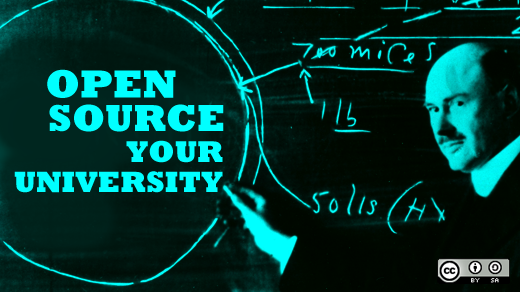Catherine Dumas is a PhD student in the College of Computing and Information (CCI) at the University at Albany at the State University of New York (SUNY). She teaches two undergraduate courses, one in the Computer Science department and one in the Informatics Department.
Aside from her PhD work and teaching, Catherine is very involved in encouraging men and women to pursue their dreams in the field. She does this by staying active in the student chapter of the Association for Information Science and Technology (ASIST) and in the activites going on at the College of Computing and Information Women in Technology (CCIWiT) group. Open source software is also a topic she's passionate about, and for the past three years she has helped organize the annual Open Source Festival at SUNY.
Read more in this interview.
What repository do you use as a teacher?
We have adopted Git as a platform for developing software and hosting and sharing training materials among instructors. We have embraced Github as the hosting location for most of our repositories. In the past year we introduced Git as a topic for many of the technology classes and hosted training workshops on it. Git is now becoming a well known technology on campus. Check them on GitHub.
Does SUNY Albany encourage open source practices?
The College of Computing and Information has a very open attitude about open source software and its interplay in education. We have adopted many open source tools for teaching programming (from Scratch, to Python, PHP, Node.js and M/MUMPS), databases and web development, as well a support for non-technical writing, using platforms such as Wordpress and Wikispaces.
For my PhD work, both LaTeX and R are essential tools that I use, along with the storage and revision control of these files in Git.
What does the College of Computing and Information Women in Technology do for women?
It is an initiative that started with the New York Celebration of Women in Computing (NYCWiC), a bi-annual conference that was inspired by the Grace Hopper conference, but focused on the New York State area.
Out of this initiative, Jennifer Goodall, Assistant Dean at the Department of Informatics at the College of Computing and Information, created CCIWiT as a place for women to meet and share experiences on being a minority in the computer science and technology related fields at SUNY Albany.
The program also encourages girls in middle school and high school to pursue undergraduate and graduate studies in technology. One of the remarkable activities of CCIWiT is organizing the funding of female students to attend the annual Grace Hopper conference. This have been done for more than five years thanks to the sponsorship of SUNY Alumni and supporters.
The Grace Hopper conference can give many women, a minority in the field of technology, confidence and new ideas by bringing them together. What has been your experience?
I have attended the past four conferences and seen the growth of the event each year (about 4,000 attendees in 2013). It is an amazing experience to witness women from diverse backgrounds, academia, and industry alike, from all over the world, participating in workshops, talks, and training sessions. It is very inspiring to see the role models of successful women in technology and contrast it with the typical experience of being a minority in technology courses. It is a very empowering experience, and it has motivated me continue to pursue technology related initiatives and activities with confidence.
Read more about Open Source Day at Grace Hopper in this interview with Leslie Hawthorn.
How has the Open Source Festival at SUNY Albany grown and evolved?
The first Open Source Festival brought together a small group of about eight presenters and twenty attendees, all from inside the campus. This changed quickly for the second Open Source Festival, which had about 150 attendees and two tracks of presentations. The third Open Source Festival was held in 2013 and had two tracks of presentations, with about 200 attendees from industry, state government, and academia. In 2013, we had hands-on workshops and career activities like mock interviews for students.
As part of ASIST activities, I was one of the founders of the first Open Source Festivals at SUNY Albany, back in 2010. A few of the presentations included: Zotero, Gimp, and we even had a student demo a Thing-O-Matic 3D printer. In that process, I learned quite a bit about the different open source tools available, as well as, the philosophy of the movement, the business models, and community activities.
The Open Source Festival has been very successful at introducing students from all backgrounds to the concepts of open source. This has made a great impact, even for students who are already in the technology field.
This year the Open Source Festival will take place on March 29, 2014. The day before, on March 28 we will hold a pre-festival day of workshops. Currently, we are inviting people to submit proposals for presentations. The keynote will be by members of the OpenStack community! And, we anticipate sessions inline with the Maker movement and open hardware, focusing on: Raspberry Pis, Arduinos, 3D printing.
Many open source-related activities took place during 2013 at SUNY Albany, so we're seeing the participation and nature of topics and discussions increase. Some of those activites were: workshops on the use of Git, training sessions on how to write defensive patent publications, and training on how to participate in the development of the Linux kernel.
The College of Computing and Information was asked to help the rare diseases community. What is that relationship like?
We got involved with the rare diseases community when we were approached by Ed Fennell who leads a forum on rare diseases at Albany Medical Center. Ed was looking for students to help him create an information system for supporting the families in their communities. Given our previous experience at workshops for ASIST, and given the great strides and learning that had been coming from the Open Source Festival, we understood the basics of what was needed to get students and faculty involved and helping. A hackathon was the perfect informal, collaborative environment; and we started a series of them, to work on developing open source software for the rare diseases communities.
What we learned with these hackathon events was that it is very important to create a space where everybody can participate and contribute. This implies that we have to resist the temptation for efficiency (which is a trace of managing scarcity) and instead ensure that activities are engaging and are covered in a redundant manner by multiple people (which is a trace of managing abundance).
It has been very rewarding to see all these volunteers, students, and faculty come together—attending and helping when their schedules allow, and working together for a common good.
View the complete collection of Women in Open Source Week articles.









1 Comment